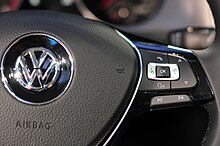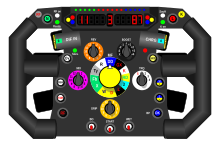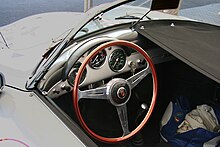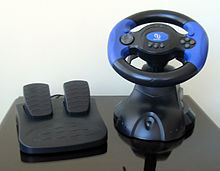steering wheel
A steering wheel (also steering wheel; obsolete valance ) is part of the steering of a vehicle , with the help of which the vehicle driver can bring the vehicle's wheels from the straight-ahead position into a steering position by turning.
Basics
Steering wheels are generally operated with the hands (unlike facilities for physically handicapped drivers). For ergonomic reasons, they are arranged at an elevation angle to the vehicle's longitudinal axis in front of the upper body so that they are easy to handle, and in cars they have a diameter of around 40 centimeters. Larger vehicles with a higher payload, such as trucks and buses , also have larger steering wheels because of the greater steering forces. Due to the different body sizes of the vehicle drivers, high-quality modern steering systems are adjustable in height and lengthways.
Historical
In 1894 Alfred Vacheron took part in the famous Paris-Rouen race. He named his vehicle "Vacheron" after his name, but it was actually an 1893 Panhard 4 hp, which he had equipped with a steering wheel. This is one of the earliest known uses of this steering principle. In the race, which was won by a De Dion Bouton steam mobile, Vacheron finished eleventh. The French manufacturer Panhard & Levassor introduced the steering wheel for its models in 1898. At the time, Rambler experimented with it, but did not introduce it. Packard and Peerless did not follow until 1901 . After that, the steering wheel became increasingly popular. A ball horn was placed on the steering wheel rim early on. Before the introduction of automatic ignition timing, it was common to integrate the corresponding levers in the steering wheel.
Steering wheels throughout history
Steering wheel and ignition adjustment of a De Dion-Bouton , built in 1908
Steering wheel with light switch of a Ford Model A , around 1930. The indicator lever has been retrofitted.
Horch 853 from 1936: four-spoke steering wheel with signal ring
Borgward Hansa 1500 (1949–1954): three spokes, each consisting of four thin metal rods
BMW 501/502 (1952–1964): Horn buttons as a circular sector instead of the fashionable horn ring
Two-spoke steering wheel of the Mercedes-Benz 190 SL (1955–1963)
DKW F91 (until 1957): steering wheel still round
"Hunchback" steering wheel of the DKW F93 (1955–1959), flattened at the bottom
Single-spoke steering wheel of a Citroën ID 19 (1955–1975)
Ford 17 M from 1961: safety steering wheel with "recessed" hub
Formula 1 steering wheel 1962: Porsche 804
Glass 1204 steering wheel (1962–1968)
Dashboard with electrical gear selection (left) and “angular” steering wheel on an Imperial Crown from 1962
Wartburg 1000 , built in 1963
Mercedes-Benz 230 SL , built in 1964, steering wheel with baffle plate
Steering wheel of a 1970s Austin Allegro , flattened top and bottom
... and a Honda Civic , 2010s
2012 bus steering wheel ( MAN Lion's City )
VW steering wheel, flattened at the bottom ( Polo V , model year 2016)
construction


The steering wheel is attached to the upper end of a steering wheel column to which several operating levers or operating satellites can be attached to the right and left . Often the emblem of the vehicle manufacturer adorns the hub or the center of the steering wheel.
In the early days, the steering wheels generally had a rim made of solid wood and held together by metal spokes, there were mostly four, sometimes five spokes. The steering wheel rims soon had a metal core that was coated with Bakelite , for example . Recessed grips on the back or underside offered the fingers more grip. There were still wooden steering wheels, but also with a metal core on which pieces of solid wood were riveted. Later, two half-shells made of precious wood were glued or riveted to the metal ring in an elaborate manual process. The wood consisted of wrapped, layer-glued veneers, mostly mahogany. A multi-layer clear varnish refined and protected the surface. The wood processing method provided high stability, was light and, in contrast to solid wood, splintered less in accidents. This type of wooden steering wheels, such as those manufactured by Nardi among others , were built into sports cars in series from the late 1940s to the 1970s or were available as accessories. Over time, real wood has been increasingly replaced by plastics with a wood grain. Because of their better grip, steering wheels covered with leather or synthetic leather became popular and soon became standard.
Most steering wheels today resemble a ring that is connected with spokes to the central part, the so-called impact pot. The horn is often located on it . Since the 2000s, other controls have often been attached to the steering wheel spokes, e.g. B. for cruise control , car radio or on-board computer . Such steering wheels with additional controls are also referred to as multifunction steering wheels (MFL). A steering wheel of this type was developed by tuner Rainer Buchmann among others in the 1980s.
Modern vehicles are usually equipped with power steering so that the driver has to overcome less resistance between the tires and the ground when steering . In large motor vehicles and construction machines, a crank knob can be attached to the steering wheel ring to make maneuvering easier.
The diameter of the steering wheel depends on the size of the vehicle. Sports-oriented vehicles have steering wheels with a very small diameter in order to bring about a significant change of direction with a short steering impulse. Large vehicles, on the other hand, have to be equipped with large steering wheels so that they do not roll when the direction of travel is changed.
In addition to their size, steering wheels in motor vehicles differ primarily in the number of spokes. A special feature was the single-spoke steering wheel in the Citroën DS and GS . The British Motor Corporation came up with the idea of a steering wheel with a flattened top and bottom, which was implemented in the Austin Allegro in 1973 . Steering wheels with a flattened bottom were already used in the DKW F93 and the Lloyd Arabella .
With the advent of the airbag in the early 1990s, two-spoke steering wheels practically disappeared. In the beginning, the use of an airbag left little design freedom, so the steering wheels were very bulky and only had an embossed manufacturer's logo. In the meantime, however, the steering wheel has become a design object again and in many cases it has also been provided with controls, for example for the radio.
Hazard potentials and their reduction
In the event of an accident, steering wheels pose a considerable risk of injury to the driver. In the course of automobile history, attempts have been made to reduce this risk through various technical devices. One example of this was Procon-ten , a development by the car manufacturer Audi , which pulled the steering wheel towards the dashboard in the event of a frontal collision using a steel cable placed around the engine block .
One of the first measures to "defuse" the steering wheels was the recessed hub or the hub set back from the steering wheel rim, followed by the impact plate (also known as the impact surface). The first vehicle with a large impact plate in the steering wheel was the Mercedes-Benz W 111 ("tail fin") from 1959. Current steering wheels, on the other hand, are usually foamed with a soft material and additionally covered with leather, in contrast to the hard plastic that was still used a few years ago . Hard plastics, like wood, often lead to injuries in accidents. It also had little grip, which is why drivers' gloves were often made entirely of leather or with leather inner surfaces. Steering wheel covers were also added to improve grip.
An important component is the airbag , which is now housed as standard in the steering wheel pot almost everywhere. A collision with the vehicle is recognized by a sensor system and an airbag is then inflated within a fraction of a second to catch the driver and thus protect him from injury.
Others
The operation of the steering wheel is crucial for the safe driving of a vehicle. When your hands are grasping the steering wheel, your arms should be slightly bent. The hands should grip the steering wheel in the middle (position about “quarter to three”). You steer by reaching over your hands so that one hand is always holding the steering wheel. Your hands should also be in the position mentioned when cornering. In this way, optimal control of the vehicle is achieved - even in the event of unexpected evasive maneuvers. Steering with one hand or with your finger between the spokes can cause accidents.
In shipping , on airships and flying boats , the steering wheel is called the steering wheel or rudder . Some motor yachts , some flying boats (especially historic ones) and airships have steering wheels that are similar to those of automobiles. In aviation , a control horn , sidestick or control stick is used instead of a steering wheel .
Steering wheels are also available as input devices for computers , some with force feedback .

In the 2011 Formula 1 season , the steering wheel of a Ferrari 150 ° Italia had over 100 functions.
literature
- Herbert O. Duncan: The World on Wheels, Vol. 1 . Veteran Car Club of Great Britain, Ashwell, Herts 1984, pp. 456-457, picture des Vacheron p. 457 (reprint of the Paris 1927 edition).
- Hans-Hermann Braess, Ulrich Seiffert: Vieweg manual automotive technology . 2nd edition Vieweg, Braunschweig 2001, ISBN 3-528-13114-4 .
- Jan Drummans: The car and its technology . 1st edition, Motorbuchverlag, Stuttgart 1992, ISBN 3-613-01288-X .
- Beverly Rae Kimes (eds.) And Henry Austin Clark, Jr.: The Standard Catalog of American Cars, 1805-1942 . 2nd edition Krause Publ., Iola, WI 1985, ISBN 0-87341-111-0 .
See also
Web links
Individual evidence
- ↑ Welt.de: Now comes the successor to the rainbow Porsche
- ↑ Patent No. DBP 854 157, Lifesaver for Thousands. In: Global Media Site Daimler AG . January 23, 2009, accessed April 4, 2019 .


























